| |
  Research
Process Research
Process |
|
Report 24 is
written on 2007/02/15 04: 37:
35 Project
hours: 22 |
|
1) Title:
Report of learnings and Chinese
documents
2) Date: 2007/02/15
3) Contents:
(1) Report of learnings filled by students, volunteers
and supervising teachers
(2) Supervising teachers revise Chinese documents of the
website. |
|
Report 23 is
written on 2007/02/13 08: 29: 33 Project
hours: 8 |
|
1) Title:
Discussion and Determination of
Key List and Subheading of the
Website
2) Date: 2007/02/13
3) Content:
(1) Determine name of key list
and arrange relevant materials
and photoes.
(2)Extend name of subheading
from items in key list, and
arrange relevant materials and
photoes. |
|
Report 22 is written on
2007/02/12 20: 59: 25 Project
hours: 4 |
|
Title:
Arrange materials and obtain
authorization from the author
Contents:
1) Task: Prepare author’s
information and obtain
authorization
2) Date: 2007/02/12 (Mon)
3) Location: the home of Mr.
Shou-liang Hsu and Fushih
Village
4) Author(s): Mrs. Ching-hsiang
Hu
及Gariyi•Jihoh
(Mrs. Ching-hsiang Hu and Gariyi•Jihoh)
5) Contents and scope of
literature
(1)Collection of Tradition
Truku Songs, volume 1 (Mrs.
Ching-hsiang Hu )
(2)New Baiyang Tribe
Orally-Spread History (Batolan
History), Gariyi•Jihoh
(3)Symbolization of Truku Fineries and Historical Culture (First
Indigenous Seminar of Research
Report for Master Degree)
Gariyi•Jihoh |
|
Report 21 was written
on 2007/02/12 08: 46: 46 Project
hours: 35 |
 |
Title: Interview Tribe Studio
(worker) of Jianqing Community
and visit New Baiyang Tribe
Content: Interview Tribe Studio
(worker) of Jianqing Community
and visit New Baiyang Tribe
 |
|
Report 20 was
written on 2007/02/07 16: 04: 46 Project
hours: 30 |
 |
|
Title:
Interview Traditional Truku
Culture Development Association
(Shioulin Township Fushih
Village )
Contents:
[Interview Date] 2007/02/07 9:
30~12: 30
[Interview Content]
The
supervisor knows an elderly, who
is striving for developing and
introducing Truku music that is
centuries-old. As our team
members are working on songs
related to weaving, we visited
the elderly’s home in Truku. The
elderly is the soul figure in
current preservation of
traditional Truku culture, who
has traveled places in order to
conserve original traditions by
collecting and recording orally
spread history, because no
literal record can be found in
the clan, causing gradual
disappearance of culture. The
translation from oral language
to written characters is a hard
process, under which, the
elderly edited and published a
book containing orally spread
meterial and traditional songs
in order that every clansman had
the chance to review ancestor’s
trace. At the beginning, she
mentioned the origin and
development of Truku, and we
just realized that ancestors of
Truku were chased by Pingpu
Tribe from Tainan to Renai
Township, Nantou, and settled
down. Later, some branches
climed mountains and moved to
Truku, because the land was not
big enough for the whole clan.
Children in my team kind of lost
interest at first, probably
because they had heard the story
or they felt sleepy, but their
attention was pulled back when
the elderly started to talking
about weaving.She said she had
learnt weaving but not the whole
skills from her mother, because
when she was born in Japanese
occupation, Japanese regarded
traditional weaving as bad
custom and restraints of
productivity potential, which
was similar to the opinion of
Nationalist Government. Although
she had tried to learn the
mature skills by herself later,
she failed because of over
complexity and time consumption,
which explained why Truku women
spent their life in weaving to
continue the process of learning
and practicing, and why the
Atayal weaving is so famous.
Next, the elderly mentioned
relevant events like beautiful
traditional songs that used
aesthetic words and rhetorical
language to indirectly express
their feelings. For instance,
the lyric used white radish to
describe girl’s skin and many
different ways. She also sang a
weaving song for us. We browsed
two books of traditional songs
she edited, in which, a song
recorded weaving steps.
Previously, people sang it while
weaving and it came down like
this. Songs are precious
treasures so that the elderly
highlights traditional culture.
She sighed that currently
culture preservation faced the
problem of fund shortage, and
many clansman gave up complete
traditional culture but
integreted wearings or songs
with other tribes to achieve
diversification for the purpose
of competition, which hindered
to present a tribe with original
picture and is inacceptable to a
culture conserver. Through the
interveiw, we experienced the
most authentic cultural
communication and discovered
that every era has its culture
but emotion is held together by
culture. We do wish our team and
work can develop Truku culture
and the public may know past
heroes who were living here. At
the end of interview, we said
goodbye to each other. The
elderly used Truku “Goodbye” but
not Chinese, which reminds us
that culture conservation should
start from daily life to deeply
embed the culture in everyone’s
heart.
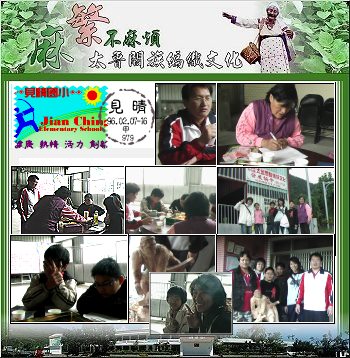 |
|
Report 19 is
written on 2007/02/06 15: 27: 04 Project
hours: 63 |
 |
|
Title:
Material producing special
website (Students materialsand
midi music)
Contents:
1) Task: Material producing
special website (Students
materialsand midi music)
2) Date: 2007/02/06AM08:
00~PM15: 00
3) Location: Computer Room
4) Participants: 4 team members,
1 superving teacher, and 4
volunteer teachers
5) Task:
(1) Scan students’ works (paper weaving, drawing and rope
weaing products)
(2)2 pieces of CD of traditional songs->MP3
▲ Study transformation
function of CD ex software
▲ Study operation
interface of CD ex software
▲ Know how to transform
CD video to MP3 document and
store them after classified
(3) Transform weaving dance music MIDI to Wav and MP3
document
▲Know build-in “recorder”
program of Windows XP
▲Adjust volume of source
for recording program
▲Transform CD to Wav
document
▲Store document as MP3
via CD ex transforming software
4) Know operation of Waw, MP3
and Midi document in daily life
and web production
5) Upload and share
Please refer to : http:
//210.240.88.194..
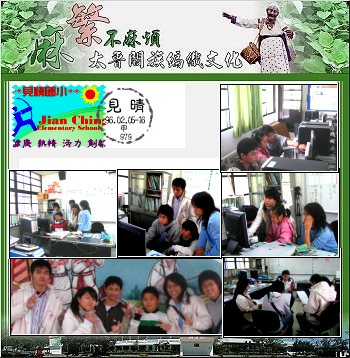 |
|
Report 18 is
written on 2007/02/05 15: 26:
18 Project
hours: 40 |
 |
|
Title:Uploading Interview
Learnings and Producing MIDI
Document of Weaving Songs
Contents:
1)Task: Uploading interview
learnings and producing MIDI
document of weaving songs
2) Date: 2007/02/05AM08:
00~PM16: 00
3) Location: Computer Room
4) Participants: Participants: 3
team members and 2 supervising
teachers
5) Task:
(1)Upload interview learings of
Tongmen Community
(Reference->http:
//210.240.88.200/xoops/modules/newbb/viewforum.php?forum=18)
(2) Record drawings
(Illustrations of fairy tales)
(3) Know the meaning of
traditional songs of weaving
(4) Know and operate song
production software like “master
in half day” and “composer”
(5)Produce MIDI document of
dance music of weaving and
upload to New Baiyang Cultural
Community Information Website
for share
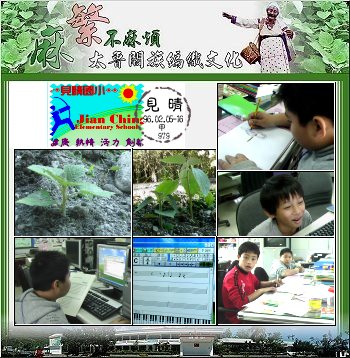 |
|
Report 17 is
written on 2007/02/04 08: 09: 09 Project
hours: 4 |
 |
|
Title:Complicated yet Easy,
Truku Weaving Culture Sitemap
Contents:Complicated yet Easy,
Truku Weaving Culture Sitemap
1. Home
1) Project Background
(1) Cultural background
(2) Field courses
(3) Professional teams
2) Local features
3) Web guide
2. New
Baiyang Tribe
1) Tribe migration
2) Heroic figures of the Tribe
3. Acquire
weaving culture
1) Meanings of Truku weaving
2) Truku Weaving Process
3) Truku Weaving Tools
4) Truku weaving skills
4. Interview
of community experience
1) Hongyeh Community
2) Tongmen Community
3) Wanrong Community
5. Experience
of Cultural Courses
1) Knowing Ramie
2) Collecting Ramie
3) Planting Ramie
4) Experiencing ramie scratching
5) Paper Weaving
6) Hands-on with Pounding Dyeing
7) Hands-on with Blue Dyeing
6. Display of student works
1) Paper Weaving
2) Works of plant-dyeing
7. Progress
Report
1) Field visit
2) Field interview
3) Data Collection
4) Research Conclusions
5) Acknowledged units
6) Research Teams
7) References
--------------------------------------------------------------
Please contact us if each
research team has any concerns. shouliang120845683@yahoo.com.tw |
|
Report 16 is
written on 2007/02/03 18: 39:
50 Project
hours: 60 |
 |
|
Title:
Interviewing cultural and
history-related staff in Tongmen
Contents:
1) Subject of interview: (1)
Migration history of ancestors
of Jianqing Tribe
(2) Fairy tale of Truku’s origin
(3) Talking about funny stories of Jianqing Tribe
(4) Meaning of weaving totem
(5) Introduction of dyeing ramie thread
2)
Interviewees:
(1) Gariyi•Jihoh,
master of anthropology
institute, Tzu Chi University
(2)Ms. Huimei Wen, Field
investigator of community tribe
3)
Participants:
(1) 5 team members
(2) 2 supervising teachers
4) Date of
activities
(1) Major activity:
2007/02/03AM08: 00~PM16: 00
(2) Video material arrangement
and archiving : 2007/02/03PM20:
00~PM24: 00
5) Rules of
holding activity:
(1) Review and improvement of
yesterday’s activity
(2) Prepare interview materials,
equipment and assign
responsibilities
(3) Interview etiquette workshop
(4) Field interview
(5) Visit community studios and
elderlys
(6) Arrange interview records
and return tools/equipments
6) Take DV
and store it as DVD video tape
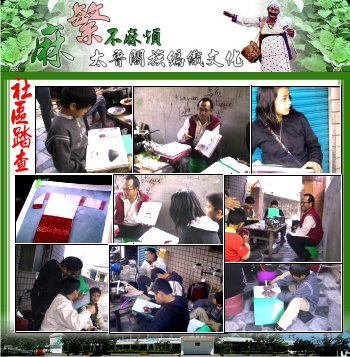 |
|
Report 15 is
written on 2007/02/03 01: 38:
25 Project
hours: 52 |
 |
|
Title:Interview Hongye (the
process of thread cooking, ramie
root collection and planting)
Contents:
1) Date: 2007/02/02 (Fri)
AM08: 00~PM16: 00
2) Location: Hongyeh Community
3)Participants: 5 team
members, and 1 supervising
teacher
4)Tools: 2 digital videos, 1
recording pen, and interview
records
5)Interview process:
(1) Read information
downloaded from webpage (the
whole process of weaving and
name of weaving tool)
(2) Thread cooking process
of Ma’am Yuyoh
(3) Acquire name and
function of weaving tools
(4) Ramie root collection
(5) Plant ramie roots in
campus and community
(6) Upload learnings
6) Arrangement of follow-up
interview (visit cultural and
history-related staff in Tongmen)
7)Transform DV tape to DVD
video
 |
|
Report 14 is
written on 2007/01/30 04: 28:
48 Project
hours: 60 |
 |
|
Title:Preparation of
interviewing next tribe
Contents:
1)Contents of report :
Preparation of interviewing next
tribe
2)Work assignment:
◎Supervisor
Xu: responsible for
administrative communication and
investigation of interview
location
◎Teacher Hua: responsible for
planning interview record and
internet question courses of the
students.
◎De-lin Ai: responsible for
instructing team members doing
research online for relevant
information
◎Volunteer teachers: responsible
for instructing upload of
learnings after interview and
webpage production
3) Interview
location:
(1)Tongmen Mugu Muyu Industrial
Development Association: inquire
traditional weaving tribes to
investigate field nformation
(2)Gariyi•Jihoh,
master of anthropology
institute, Tzu Chi University
(3) Fushi Village Cola Culture
Heritage Promotion Association
4) Collection of internet
informatin: (source of
references: E Tribe of Cola
Culture heritage Promotion
Association
1.Meanings of
Weaving:
In the
history of Truku tribe,
“weaving” was a necessary
traditional skill to women, as
important as “hunting” to adult
male as a symbol. Women should
take care of producing cloth and
wearings for the whole family
besides farming and housework,
from ramie planting, collection,
peeling off bark, extracting
yarn, weaving, dyeing cloth to
completion. Every step requires
extensive patience and
chariness, which revealed the
life of Truku women was
respectable as full of
hardworking. In the custom of
Atayal tribe, mastering weavng
was regarded as the standard to
decide the woman to be an adult,
when the woman could be face
tattooed and ready for marriage.
Those with outstanding weaving
skills had the privilege to
tattoo certain patterns in
chest, hands, feet and forehead
to symbolize the honour, and
would become the objective
pursued by young warriors.
2. Weaving
process:
1) Level gallus machine (also
called waist level weaving
machine): including ramie thread
process, thread spinning,
cooking thread, arrange
longitude, weaving cloth
(1)Ramie thread process: get
rid of leaves->peel off ramie
bark->cut ramie->clean and
wash->sun-bake.
(2)Thread spinning: piling
ramie (pile ramie fibre
together) -> (use spindle to
firm and smooth bed line)
(3) Thread cooking: put ramie
thread in iron pot together with
cold water and wood ash, cook
for two hours to get rid of dirt
and impurity from ramie, and to
bleach the thread (if thread
dyeing is required, add in juice
of dioscorea ehipogoniordes and
lixivium, and cook with chopped
corm of dioscorea ehipogoniordes
to dye brown, black or ruddle).
(4)Arrange longitude: arrange
irrelated thread to be connected
thread groups with equal length
by using longitude arrangement
frame, and put the longitude
thread in order.
(5)Weaving cloth: on shelf
(move longitude thread from
longitude arrangement frame to
weaving machine) -> winding
shuttle (wind latitude thread to
shuttle)
3. Modern
desk weaving machine: position
the machine, produce heddle
thread, arrange thread, arrange
thread with thread pulling
stick, on shelf, and weaving
commencement.
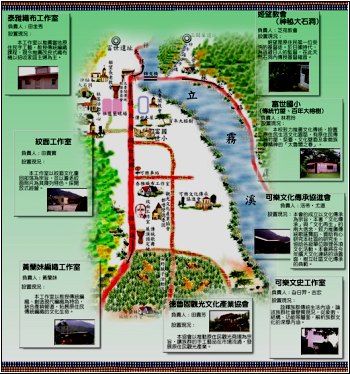 |
|
Report 13 is
written on 2007/01/27 11: 56: 53 Project
hours: 6 |
 |
|
Title:
Summarize Student learnings as
report (blue-dyeing learnings)
Contents:
1) Contents of report: Summarize
Student learnings as report
(blue-dyeing learnings)
2) Accordance: Report 5 (written
on 2007/01/21 09: 11: 06)
▲11.14.2006
Exploring subject (senior) cloth
dyeing course (1)
▲11.21.2006
Exploring subject (senior) cloth
dyeing course (2)
3) Summary method:
(1) Team members should
summarize individual learnings
on line and store them in word
editor.
(2) Copy image of information
board in screen with Print Scrn
SysRq (above key Insert)
(3) Edit the document with
PhotoImpact software and post it
in the report.
4) Time calculation:
(1) Course time
(2) Time for students’ writing
learning report
(3) Time of students’
arranging past learning online
(4) Time of image process
supervisor instructing students
in edition
(5) Time spent in printing the
report
5) Jianqing Elementary School:
http: //210.240.88.200/xoops/modules/newbb/viewforum.php?forum=18
6) Student’s learnings:
-----------------------------------------------------------------------------
[Kang-chuan Liu]
learnings of blue dyeing
Tools: 1. gloves, 2. cloth, 3.
blue water, 4. clean water
First use clastic to bind cloth
that has been processed by the
teacher
You can bind it by yourself for
different feelings
After bound, stir the cloth in
blue water
After release of blue water,
fill in clean water
If fill in blue water, the color
would be more vivid. Pay
attention, replacing blue water
with clean water should be done
after careful stir.
Stir makes color even
If you decide it’s enough, you
can take the cloth out of the
water
After taking cloth out, first
release the elastic binding
cloth
Then, take sun-bake
Learning: I feel the process is
simple. One can produce his/her
own figure to endow the cloth
with perfect feeling if exerting
individual talent.
-----------------------------------------------------------------------------
Shi-wei Yan]
Blue dyeing
Tools: cloth, blue water, and
gloves
Steps:
The teacher distributed
processed cloth to us.
1. First wear gloves, because
hands may turn blue without it.
2. Rub the cloth, especially the
place binding elastic.
3. Put rubbed cloth in clean
water and rub it.
4. If prefer deeper color, you
can re-dip the cloth in blue
water.
5. After these steps, let the
cloth do sun-bake
6. The work is done then.
Learnings:
I think our teacher is smart,
knowing things that happened
long ago.I think past elderlys
are smart, because they know
what color can be dyed by using
different leaves. Moreover, they
won’t use chemical stuff to make
material.So smart.Besides, we
should learn the spirit of
elderlys in the past.I should
learn our teacher’s spirit.Thank
our teachers for giving us so
many materials.
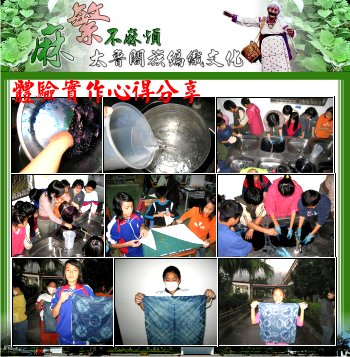 |
|
Report 12 is
written on 2007/01/27 05: 08: 03 Project
hours: 15 |
 |
|
Title:
Summary of student learning
reports (pestle-dyeing learnings)
Contents:
1)Content of report: Summary of
student learning reports
(pestle-dyeing learnings)
2)Accordance: Report 5 (Written
on 2007/01/21 09: 11: 06)
▲950919
Exploring subject (senior): the
page to acquire ethnic plants:
catch your outline (1)
▲951003
Exploring subject (senior):
catch your outline (2)
3) Summary methods:
(1)Members arrange past
learning reports online and
store additionally in word
editor.
(2)Copy image of information
board in screen with Print Scrn
SysRq (above key Insert)
(3)Edit with PhotoImpact
software and post in the report.
4)Time calculation:
(1)Previous time for students’
writing learning report.
(2)Time of students’ arranging
past learning online
(3)Time of image process
supervisor instructing students
in edition
(4)Time spent in printing the
report
4) Jianqing Elementary School:
http: //210.240.88.200/xoops/modules/newbb/viewforum.php?forum=18
5)Student learnings:
[Yan-ling
Wu]
Pestle-dyeing learnings
Self-prepared tools
1. first self prepare aluminum
foil pack, 2. prepare iron
pestle
Steps:
1. take some leaves, 2. put
aluminum foil underneath, 3.
leaf figure
Operation process:
During the pestle-dyeing
process, Shen-wei Huang’s team
beated too heavy so that
teachers downstairs thought that
terrible things would had
happened, similar to Ji-ming
Li’s team that shaked the desk.
I hit my hand when first used
the pestle, so I gave up as felt
painful and teacher Chen helped
me in pestle-dyeing.
Learnings:
The most impressive thing was I
was shot when operating. I
refused and said that I was not
beautiful, but the teacher said
I was. Unfortunately, I hit my
hand right after the picture was
taken. The teacher asked me:
“what happened?” I told her:” I
hit my hand. It is you who make
me hand hit.” My teacher
laughed, and I asked what she
was laughing for, but the
teacher didn’t answer me. When
the work was almost done, others
were shouting and laughing, I
tried to stop them but they said
I was tough. I fought back that
it was noisy if people were
shouting.
[Chi-cheng
Ma]
We used cloth, pestle,
aluminum foil and leaves for
pestle-dyeing. We should hit
heavily, so that some students
did over-heavily but some
lightly. I did heavily and
people downstairs thought
something happened like in a
fairmarket. Steps of
pestle-dyeing includes: 1. put
cloth on aluminum foil, 2. place
leaves under the cloth, 3. use
pestle to hit the area with leaf
underneath. I felt pestle-dyeing
was interesting as the cloth
could be dyed color by hitting.
Also I thought it dangerous,
because it might be easy for
people to hit their own hands in
operation, and if so, their
hands would be bloated. I would
like to thank teacher Chen for
teaching us many dyeing methods,
and for the hardworking.
[Jun-feng Wang]
Learnings of pestle-dyeing
Tools: 1. aluminum foil pack, 2.
leaves, 3. cloth, 4. iron pestle
Steps:
1. Teacher distributed processed
cloth to us.
2. Let us choose leaves.
3. Take aluminum foil pack with
us.
<1> First place leaves on
aluminum foil with back upwards,
and put processed cloth over
leaves. Now start to hit with
iron pestle. If you prefer
different feelings, you can use
only half of your power. All
teachers believed we were hiting
something upstairs and would
check us, when we were doing
pestle-dying. Finally, we
submitted the cloth to our
teacher.
I learnt lots of knowledge and
understandings in pestle-dyeing.
I realized that even though the
steps were simple, but success
was only based on working with
heart. If I had chance, I would
learn from our teachers again.
Jianqing Elementary School:
http: //210.240.88.200/xoops/modules/newbb/viewforum.php?forum=18
 |
|
Report 11 is
written on 2007/01/26 11: 11:
59 Project
hours: 16 |
 |
Title: “Progress report” and
picture upload practice in
“information board”
Contents:
Subject of computer tutorial:
“Progress report” and picture
upload practice in “information
board”
(Lecturer): Mr. Shou-liang
Hsu
(Tutor): Mr. De-lin Ai
(Date of Tutorial):
2007/01/24 pm12: 30~13及
pm16: 30~17: 30
Content of course:
1)Upload pictures using learnt
image process software.
2)Information board of Team
Studio serves as upload practice
area.
3)Students know how to online
download activity pictures and
sample documents from school
server.
4) Adjust size and pixel of
pictures.
5)Each sample document can
contain 6 pictures.
6)Log on line to browse
pictures.
Expected effect︰
1) Students can process image
size and contrast independently
as well as upload their works to
the website.
2) Downsize for the limited web
capacity. |
|
Report 10 is
written on 2007/01/25 00: 56: 47 Project
hours: 4 |
 |
Title: Summary of student
learning report
Contents:
Student Learning Report:
Date: 2007/01/20 (Sat)
Location: Hongyeh Elementary
School
Referred website: http:
//210.240.88.200/xoops/modules/newbb/viewforum.php?forum=18
Learnings of team members:
[Yan-ling Wu]
Time: 20 January. Location:
Hongyeh Village. Participants:
Shi-wei Yan.Kang-chuan
Liu.Meng-ci Li.Jun-feng Wang.Yan-ling
Wu. Event: interview Mr. Lv, the
supervisor. Tools: digital
video, recording pen. Content of
course: Method and process of
cloth production
1.Collect ramie
2.Spin thread (process ramie,
spin, frame)
3.Bleach (bleaching and dyeing)
4.Thread arrangement (wind
thread, arrange thread,
longitude arrangement)
5.Weave (on shelf, weave cloth)
I found standing and desk
weaving machines on the spot,
and desk machine were used by
kids of Hongyeh Elementary
School. Currently, most students
just made head strips.
They weave after class.
The vertical thread is longitude
thread, and the horizontally
transversing one is latitude
thread. I know there are 67
lines of the weaving sample in
blackboard.
A: Royal blue B: Peach C:
Purple D: Red E: Magenta F:
Beige G: Dark green
A B C D
2 4 2 1
up up up up
down down down
up
down
[Shi-wei Yan]
On 20 January, our team members
interviewed Mr. Lv, the
supervisor of Hongyeh Elementary
School.
We set out at 8:30 to visit Mr.
Lv, the supervisor in Hongyeh
Elementary School, during which
we bought chewing gum in 7-11.
First, Mr. Lv chatted with Mr.
Xu, while students of Hongyeh
Elementary School, “Wei-jie Li”
and “Shi-qiang Yan”, were
talking with us. The next, Mr.
Lv showed us around weaving room
of Hongyeh Elementary School,
where was equipped with many
weaving machines, including
standing and desk ones. The
former was used by teachers and
the latter by students. Then,
their students demonstrated
weaving for us, which surprised
us greatly. I know how to draw
the practicing figure of Hongyeh
Elementary School, as follows:
A B C D C D C B E F G F G F G F
G F E B E
2 4 2 1 2 1 2 4 3 1 1 1 1 1 1 1
1 1 3 4 3
F G F G F G F G F E B C D C D C
B A
1 1 1 1 1 1 1 1 1 3 4 2 1 2 1 2
4 2<Do you understand these
character symbols? These are
weaving password of Truku.>
After interview, we took
pictures with students of
Hongyeh Elementary School. And
then, the supervisor took us for
spa where we had a whale of
time, pouring cold water at
others even though we had single
rooms for everybody and could
adjust water temperature. After
spa, we went for lunch and took
the chance to meet Mr. Cheng,
when we listened to some music
and felt happy. In completing
the meeting, we had to leave so
that Mr. Xu took us home, when
the beautiful day ended.
[Kang-chuan Liu]
On 20 January, we visited Mr. Lv,
the supervisor and students of
Hongyeh Elementary School. They
were weaving recently, taught by
people from Ji’an, Hualien.
First, Mr. Lv told us about
weaving courses, but was not
sure of details as he was not
the professional weaving
teacher. Mr. Lv let his students
demonstrate weaving for us as
well as teach us weaving
process. For example:
1. A B C D 2. A: Royal blue F:
beige 3. latitude thread use B
color, about 5-
2 Up 21 B: Peach D: Dark green
6cm in width, total 70
UP Down UP Up C: light purple
circle
Down Up Down D: Red
Down E: Magenta
After enquiry, we got to know
students of Hongyeh Elementary
School wove in winter vacation
or after class, and currently
they only made cap and coif.
They had standing and desk
weaving machines, the latter of
which was made by students
themselves.
 |
|
Report 9 is
written on 2007/01/24 22: 31: 00 Project
hours: 8 |
 |
|
Title:Computer Tutorial Class –
Team Studio basic information
revision
Contents:
Subject of Computer Tutorial:
Team Studio basic information
revision
Lecturer : Mr. Shou-liang Hsu
Tutor: Mr. Shou-liang Hsu, Mr.
De-lin Ai
Date (Date of Tutorial):
2007/01/23PM16: 30~15: 30
Contents of Course):
1)Download personal picture
from the school website: New
Baiyang Cultural Community
2)Use photoshop software
learnt this noon to upload
personal standard picture
according to pixel and size
requirements of Team Studio
3) Revise personal information
4) Use information board in
Team Studio
 |
|
Report 8 is
written on 2007/01/23 13: 29: 19 Project
hours: 8 |
 |
|
Title:Subject
of Computer Tutorial:
Photoimpact image process
Contents:
Subject of Computer Tutorial:
Photoimpact operation
environment
Lecturer: Mr. De-lin Ai
Tutor: Mr. Shou-liang Hsu, Ms.
Shu-jun Hua
Date (Date of Tutorial):
2007/01/23PM12: 30~13: 30
Contents of Course: (Outline of
contents is from Blockbuster_PC/Video
Workshop)
1) Photoimpact operation
environment
(1)Open a new document
(2)Visualization opens
2)Introduction of important
storage format
(1)How to store documents as
editable document format
(2)Store image as smaller
format, and optimize image
3)Basic process and format of
pictures
(1) Size adjustment with
photoimpact
(2)Adjustment of contrast and
brightness
4) Basic process and format
upgrade of pictures
(1)Add frame for pictures
(2)Adjust the picture in
transparence and fade effect
(3)Control the context of
picture layers and orders of
pictures
(4)Proportion issue of picture
and document
(5)Zoom in and out pictures
with modification tools
(6)Is stuff combination
needed?
5) Utilization and operation of
tool kit |
|
Report 7 is
written on 2007/01/23 09: 49: 47 Project
hours: 9 |
 |
|
Contents:
Subject of computer tutorial:
Figure/ document manager ---
acquire acdsee image software
and photo management
Lecturer: Mr. De-lin Ai
Tutor: Mr. Shou-liang Hsu, Ms.
Shu-jun Hua
Date (Date of tutorial):
2007/01/22PM12: 30~13: 30
Contents of course: (Content
outline is from Blockbuster_PC/Video
Workshop)
1)Start up switch between
acdsee and image browser
2)Image window function
A04 Picture order
A05 Display picture zoom
A06 Fraction display of
image
A07 Auto-zoom to proper
size
A08 Setup of auto-play
A09 Synchronized document
folder_when adding or deleting
pictures, icon display would
change automatically
A10 Change picture to
tablecloth
3) Function of pre-view
window
B01 Copy/move image
B02 Copy/move images
B03 Copy/move by pulling
mouse
B04 Re-name image document
B05 Delete image document
B06 Change the size of
miniature
B07 Transform of many image
format to JPG that is accepted
by webpage
4) Image editor---simple
modification of image
C01 Turn the angle of image
C02 Color balance__Change
the color of image
C03 Adjustment of
brightness and contrast
C04 Fuzziness and
definition
C05 Production of bicolor
picture
C06 Negative__embossment
effect
5) Upload information to
school server
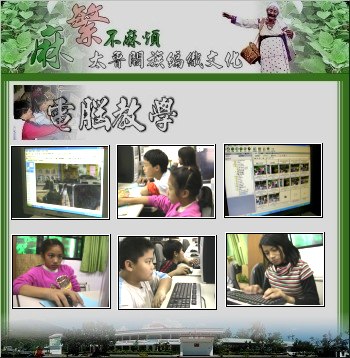 |
|
Report 6 is
written on 2007/01/22 17: 37: 47 Project
hours: 10 |
 |
|
Title:Report
of learnings from interviewing
Hongye and summary of student
achievements at semester end
Contents:
Date: 22 February 2007
(16:30pm—17:30pm)
Location: Computer Room
Content of learnings: please
refer to following connection
for details
http: //210.240.88.200/xoops/modules/newbb/viewforum.php?forum=18
|
|
Report 5 is
written on 2007/01/21 09: 11:
06 Project
hours: 10 |
 |
|
Title:
Summary of Implementation Status
of Each Team
Contents:
Time
Work summary
08232006~082962006
School administrators assessed
if participating Cyberfair
08252006~082662006
Contact with universities,
colleges and clubs
08292006 School Affair
Meeting at Semester Beginning
09012006 Set up Student
Cultural Group
09022006 Assign group
members
09082006 The page to
acquire ethnic plants (1): first
touch
09152006 Field ramie
collection and acquire its
growing environment
09182006 Hold PTA
09192006 Exploring
subject (senior) to acquire
ethnic plants: catch the outline
(1)
09222006 Collect
information online and upload learnings
09292006 First exeprience
of ramie scratching
10032006 Exploring
subject (senior) catch your
outline (2)
10132006 Plant ramie for
the first time
10142006 Training of
volunteer teachers
10172006 The page of
Plants, Exploring subject
(senior) : Attach film to
product
10192006 Community visit
(elderlys and teachers)
10620200 Plan
implementation and review
10202006 First touch of
volunteer teachers and students
10282006 Information
collection
11042006 Formal interview
and experience of students (Hongyeh
Community)
11102006 Plant ramie for
the second time
11142006 Exploring
subject (senior): cloth dyeing
course (1)
11182006 Folk-custom
craft activity in Wanrong
Township
11212006 Exploring
subject (senior): cloth dyeing
course (2)
11302006 Interview and
ramie scratching experience of
students
12012006 Invite elderlys
to our school to hold cultural
course
12082006 Webpage
production and photo arrangement
12122006 Exploring
subject (senior): simple cotton
thread weaving on hand (1)
12142006 Online
information collection and
learning upload
12152006 Observation and
protection
12152006 Weeding and
fertilization, apply for account
No.
12282006 Observe ramie
growth
01032007 Semester End
Review of Field Course
01052007 Paper Weaving
01122007 Visit parents
(chairman) of community
01122007 Final report
(photography)
01152007 Establishment of
New Paradise and weeding in New
Paradise
11152007 Observe ramie
growth
01172007 Webpage
production and photo arrangement
01172007 Acquire ramie
area
01192007 School Affair
Meeting at Semester End
01202007 Build league – Hongyeh Elementary School;
Meeting with Mr.Cheng from Hope
Agent Development
Association
01222007~0125 Courses about
picture management, image
process, learning upload
02022007 Interview Ma’am
Yu-yoh (page of weaving – thread
cooking), collect ramie
roots and plant ramie
02022007 Coordinate
affairs related 0203 interview
of Tongmen cultural and
history-related
staff
02032007 Interview Tongmen cultural and
history-related staff, and
arrange literature
materials
02042007 Coordinate
affairs related to 0205
interview of Wanrong Community
02052007 Interview
weaving elderly of Wanrong
Community
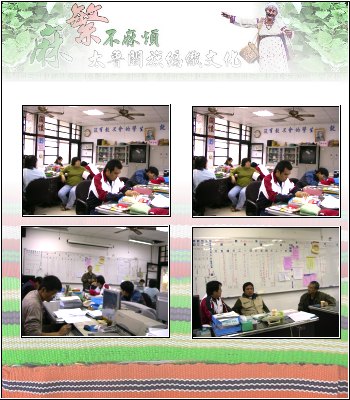 |
|
Report 4 is
written on 2007/01/21 01: 02: 41 Project
hours: 30 |
 |
|
Title:
Cultural communication between
Hongyeh and Jianqing
Contents:League building of
Hongyeh and Jianqing
1) Task:Task: lead team members
to interview Hongyeh Elementary
School
2) Date of interview: 2007/1/20
(Sat)
3) Participants: Mr. Shou-liang
Hsu
4) Participating students: Shi-wei
Yan, Kang-chuan Liu,Yan-ling Wu,
Jun-feng Wang, Meng-ci Li
5) Carried equipments: 2 digital
videos, 1 recording pen, 1
digital camera, 4 recording
boards, 4 four-color pens, and a
suit of clothes for change.
6) schedule:
(1) 07: 00~08: 30 The teacher
instructs team members in
pre-visit preparation and
interview content.
(2) 08: 30~09: 30 Scenery
along Huatung Rift Valley
(3) 09: 30~11: 00 Situation
of interviewing Hongyeh
Elementary School to promote
weaving tutorial
(4) 11: 00~12: 00 Do spa to
relax
(5) 12: 00~13: 00 Have an
appointment with Mr. Cheng from
Hope Agent Development
Association.
(6) 13: 00~14: 00 Return
safely.
7) Schedule description:
Before set-out, the team would
allocate tasks, organize groups
and introduce interview content
of that day, enabling students
to independently set up
questions while enjoying scenery
in the car. I was busy in car,
aiming at passed places to
introduce village distribution
in Wanrong Township. From north
to south, there were 6 villages
in total, such as Xilin,
Jianqing, Wanrong, Mingli, Mada
and Hongyeh.
The interview of Hongyeh
Elementary School passed Fenglin
Village, Guangfu Township and
ruisui Township, a journey about
30-40 minutes. Students just
realized how far our destination
was. In order to release their
sense of stale during the
journey, we provided video and
singing equipment to serve them
as well as snacks like chewing
gum. After interview, they were
arranged to take spa in hotel
and eat pigfoot in Lintian
Mountain. Even though the
journey is tiring, the
participants enjoy 5-star
services.
The key task is to visit
Guo-liang Lv, supervisor of
Hongyeh Elementary School, and
interview weaving students who
are team members of the school
as well. Mr. Lv and I graduated
from the same college, Hsinchu
Normal College, but younger than
me. I purposed to acquire
experience from his splendid
history by visiting him.
Although the professional
lecturer teaching weaving didn’t
show, He seriously stated the
situation his school promoted
weaving tutorial, let his
students show their skills to
us, and explained to us weaving
skills in blackboard (those were
composed by rows numbers and
English codes, looking like
weaving password map). To our
surprise, they just spent 4
courses in two weeks (about a
working day/8 hours) to work out
various colorful cloth strip.
Our A Bin had to take picture
with digital video to catch
beauties in sight, and literal
recording team kept writing down
what they saw and heard.
Permanent flare was generated in
the culture communication and
experience of “Jianqing” and
“Hongyeh” with different school
background, so that supervisors
of two school hoped to structure
“co-operative” and reciprocal
learning pattern in the field of
culture, especially interaction
among team members. They
expected to see the interaction
of students online. Finally, we
took picture together full of
sad for leaving.
The next, I led students to the
most expected place
today---“spa”. Mr. Lv
specifically contacted with spa
operator opposite to the school
to offer us NT$50, a cheap
price. The most exciting news
was Mr. Lv would pay the bill
for all students. We were kind
of surprised by our students
because they took spa in the
most “primitive” way, when they
jumped into water with clothes
as rural children playing in
brook. Waitress arranged
everyone in private compartment,
but they raised water fighting.
As the teacher leader, I
probably had lost my face. Next
time, I should mention the point
in pre-visit training of
visiting Hongyeh and taking spa.
Later I chatted with Mr. Lv and
Mr. Cheng from Hope Agent
Development Association in
Lintian Mt. Pigfoot Restaurant
at noon, when my students were
tasting pigfoot of different
flavour. Mr. Cheng came to
control status of coordination
between volunteer teachers and
schools. We stated actual
implementation, and hoped in the
coming days more potentials
could be exerted to achieve
common mission bestowed to us.
In the journey of “go” and
“return”, I shot my left sight
in the rearview mirror,
discovering that figures of
students in the mirror reflected
their feeling of happy and
expecting in set-out and their
tired but satisfied face while
returning home. As they have
been sent back safely, I would
like to mark a perfect full stop
for today’s activity and put
down the burden of task.
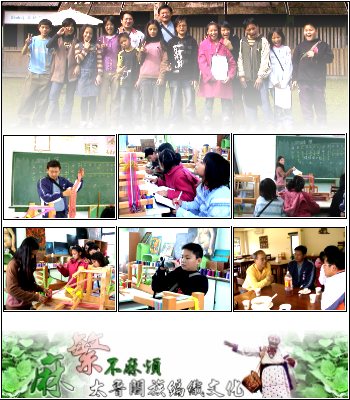 |
|
Report 3 is written on
2007/01/20 00: 57: 54 Project
hours: 4 |
 |
Title: Teacher Communication and
Resolution Proceedings of School
Affair Meeting at Semester
Beginning
Contents: Resolution Proceedings
of School Affair Meeting at
Semester Beginning
Proposal for discussion: Our
school will participate in
cyberfair. Discuss which teacher
can support the project? Which
student can participate in? Can
school provide equipment support
for research?
Proposal for discussion:
Shou-liang Hsu, Director of
Education
Discussion participants: All
teachers and school staff
Date of discussion: 29 Auguest
1995 (Tues)
Location of discussion:
Teacher’s office
Proposal statement:
After discussed in the
administrator related meetings,
the school will lodge the
application for attending
Cyberfair to upgrade student’s
research ability in exploring
subject and to motivate
professional acknowledgement of
teachers. After communication
and confirmation between the
school Principal and responsible
individual, the current
supportive external resources
include Hope Agent Development
Association, assisting in a
series of education and training
courses as well as translation,
and Sunny Club of Hualien Dong
Hwa Education University,
assisting student supervisor in
webpage production, learning
uploading and operation of
information technological
equipment. Measures coordinating
cyberfair in the school can be
implemented according to
original course proposal,
namely, New Baiyang Cultural
Community and two course
programs of senior grade
exploring subject. Therefore,
special discussion is lodged in
the school affair meeting at
semester beginning. Please put
forward your precious opinions.
Contents of decision:
1) Supervising teachers:
(1) Mr. Shou-liang Hsu:
▲Service
seniority: 11 years
▲Education
background: 84 graduate of
Chinese Education Department,
Hsinchu Normal College
▲Specialty:
traditional singing and dancing
training, set up server website,
aethetic design of webpage, and
professional figure edition.
▲Task:
Plan/application composing and
proposing, coordinator between
Admin. Units and the community
tribe studio, and web design.
(2) Ms. Shu-jun Hua:
▲Service
seniority: 3 years
▲Education
background: 88 graduate of
Hualien Normal College (Year 2
student of Environment Research
Institute, Hualien Education
University)
▲Specialty:
editor of local cultural
courses, and researcher of local
plants
▲Task:
edit local cultural courses and
supervise subject-exploring
program.
(3) Mr. De-lin Ai:
▲Service
seniority: 8 years
▲Education
background: 87 graduate of
Primary Education Department,
Hualien Normal College
▲Specialty:
set up server website and design
webpage.
▲Task:
tribe language translation, web
design and student management.
2) Participating student:
(1) Shi-wei Yan: Male,
12-year old, student of grade 6,
an excellent student with high
morality, strong
information-related ability with
computer accessing to internet
at home.
(2)Kang-chuan Liu: Female,
12-year old, student of grade 6,
excellent student with high
morality, strong
information-related ability with
computer accessing to internet
at home.
(3)Chi-cheng Ma: Male,
11-year old, student of grade 5,
excellent student with high
morality, strong presentation
ability, and no computer at
home.
(4)Jun-feng Wang: Male,
11-year old, student of Grade 5,
excellent student with high
morality, strong presentation
ability, and no computer at
home.
(5)Yan-ling Wu: Female,
11-year old, student of grade 5,
excellent student with high
morality, strong
information-related ability with
computer accessing to internet
at home.
(6) Meng-ci Li: Female,
10-year old, excellent student
with high morality, modest and
quick learning.
3) Supportive equipments:
(1) 2 digital video
(2) 2 digital cameras
(3) A scanner
(4) A special server
(5) 4 PC (Windows XP Pro)
(6) 3 recording pens
(7) 8 interview record boards
(8) 1 laptop
(9) A bicycle |
|
Report 2 is
written on 2007/01/19 23: 12:
45 Project
hours: 1 |
 |
|
Title:
Generation of cooperating
partner
Contents:Contact with clubs of
universities and colleges
Date of contact: 25 August 2006
(Fri)
Contact person : Mr. Shou-liang
Hsu
Object of contact:Yueh-shan Lyu,
Cunny Club, Donghua University
Content of interview:
Mr. Shou-liang Hsu:
Our school applied to Hope Agent
Development Association for
participating in Cyberfair that
would involve some teachers and
students in this year’s
activity. The association
expects us to organize a team of
volunteers to assist in webpage
production and operation of
information media. Herein, we
sincerely invite your club to
join us.
Ms. Yueh-shan Lyu:
What brought you to contact our
club?
Mr. Shou-liang Hsu:
As your club had organized
student summer camp, presenting
close interaction and excellent
privity between volunteers and
students. Furthermore, the team
leader of summer camp, Mr. Huang
is the student of Information
Engineering Department,
combining with the situation
that many students of
Information Engineering
Department would attend relevant
activities of your club, so that
we expect to cooperate with you
resulted from the discussion in
our teachers and I am
responsible for the contact job.
Ms. Yueh-shan Lyu:
As Director Xu has contacted
with our club leader before, our
club has initially agreed to
communicate with your school as
an internal decision, and will
further discuss with you about
cooperation and manpower
configuration. I am in charge of
contact with your school, so you
can talk to me about Cyberfair-related
affairs.
Mr. Shou-liang Hsu
In order to smoothly carry out
relevant work by participating
teams, Hope Agent Development
Association organizes a series
of auxiliary activities and will
handle training activity and
expense support. I do hope we
can bring chances of development
to children here and let them
involved in deeper and wider
local culture. |
|
Report 1 is
written on 2007/01/19 22: 40:
03 Project
hours: 3 |
 |
|
Title:
Decision of engagement in
research and exploring
Contents:
Proposal for discussion: How to
promote feature of our school
Proposal for discussion: Rong-fang
Zhu, Principal
Participants of discussion: Rong-fang
Zhu (the Principal), Mr.
Shou-liang Hsu, and Mr. De-lin
Ai
Date of discussion: 23 August
1995 (Wed.)
Location of discussion: Computer
room
Context
of issues:
1)In order to encourage
each school to develop its
unique feature and to construct
high qulity education
environment with new view in new
century, Hualien County
Government Department of
Education suggests each school
should promote 1-2 items as its
features.
2)As a school in indigenous
region, our school can promote
traditional cultural and
educational activities of
indigenous people as well as
local cultural courses, under
conditions of the special human
and geographic environment.
3)We have got good results in
activities promoting Indigenous
traditional culture and
education, including traditional
dancing, music instruments and
toxophily.
4)In course implementation in
past three years, many teachers
of our school developed various
courses related to local
culture, including experience
activities of hunting, ethnic
plants, traditional food, and
orientation of traditional music
instruments, etc. Moreover, the
school added weaving culture and
extending courses of above
activities in this year’s Course
Development Program.
5)The principal previously
served Fengbing Elementary
School that once got good
result, and Guo-liang Lv, the
supervisor of Hongyeh Elementary
School has been a superior of
Cyberfair, which enable us to
acquire relevant information
from other school’s experience
and communication.
Contents of discussion and
decision:
1)Our school plans to continue
our features in traditional
dancing, music instruments and
toxophily, according to Priority
Region Ratifying Plan this year
by the Department of Education.
2)In order to promote research
ability in subject exporing,
students from senior grades were
selected as well as teachers
with high commitment and passion
to participate in the Cyberfair
project.
3)Plan to push Supervisor Xu to
contact his counterparts in
Fengbing Elementary School and
Hongyeh Elementary School,
expecting to gain support of
Hope Agent Development
Association.
4)Contact for cooperating
partner from clubs of
universities and colleges in
Hualien County.
5)Course of subject exploring
and field interview experience
activities are conducted
synchronously to coordinate with
school culture courses, which
can get twice the result with
half the effort.
6)The subject of research
temporarily decides weaving
cultural course promoted by New
Baiyang Culture Community as
research scope.
 |
| |
 |
|
The 7th
meeting material of NDHU Sunny
Club |
|
The sixth
record: observing ramie growth
with students
2007/01/17
14: 00~16: 00
This is the first time seeing
students planting ramie that
gradually grow up after twice
transplanting. Students told me
those ramie were transplanted by
the Supervisor from a neighbour
growing them to the garden of
Jianqing Elementary School, near
the playground. But the garden
could not receive sunshine,
requiring transplant of ramie to
places with sunshine according
to elderly’s opinion. Original
plants should be removed.
Unfortunately, probably because
of property of soil, the
transplant caused triving ramie
decayed, and the Supervisor and
students had to re-transplant
them to another place, namely
the back of park (wind and rain
classroom), where were covered
by rubbish. To our surprise, the
transplant was successful, which
probably implied that we should
not think low of noteless
things.
Planting ramie in school
purposed to enable students to
observe and record ramie growth
conveniently, as well as
providing better environment for
ramie reproduction, for
currently few would grow ramie
with the dramatic reduction of
demands.
When I visited the school, I got
a small land from a parent for
ramie planting, which was
managed by students themselves.
I was astonished when I saw it
by the effort and contribution
the students had made. In fact,
the land was originally full of
stone and weed. Students told me
they got bleb in hand because of
working, enable them to
understand it was not easy to
grow a plant, and needless to in
the past when people lived on
that. I believe students will
more treasure the land and ramie
babies bearing their effort and
cooperation. |
| |
 |
|
The 6th
meeting material of NDHU Sunny
Club |
|
The sixth
record: arrange ramie materials
Weaving is the feature of
indigenous culture. Human is
covered with cloth from birth to
death, which depends on weaving
activity of women. Therefore, a
woman’s weaving skill decided
her social status in the tribe
then. The source of ramie thread
as the material of weaving –
ramie was regarded as the
indispensable plant, and is
still the most traditional
weaving material in the eyes of
Atayal people, because ramie is
the only weaving material that
can be planted independently
without relying on import. So,
in the past, almost every family
would plant ramie, the size of
which represented the wealth of
a family. Ramie yarn is its
fibre after cortex peeled off,
which can be used in many
places, such as weaving cloth,
making clothes, producing rope,
backbelt for men, fillet or
waistband, hand basket, fishing
net, catcher, and the like.
Ramie belongs to perennial
herbage Urticaceae plant,
growing warm hillside with
abundant rainfall. Its existance
appears in road side and valley.
The plant can be grown at the
coign of new assart or around
the burnt and cultivated land.
Ramie used seeds to cultivate
young tree, generally adopting
offshoot method. Ramie leaf is
green and ellipse, and will turn
light yellow when getting
mature, with dense white short
floss covering leaf back. Young
ramie has green stick that will
turn black in mature and will be
cut down for producing ramie
yarn with bamboo-made peeling
tool. Ramie growth requires over
3-4 months so that the plant can
be harvested three times a year.
The infield should be changed
3-4 years later as well as ramie
garden. In initial spring, we
can harvest the best and most
ramie, slim, breakable but
coriaceous. In cold weather,
ramie fibre will be shorter than
usual, so that the best for
ramie planting is warm season.
After leaves
removed, the cut ramie stick
should be processed as following
steps before used in weaving:
(1) Twist the
stick to break cortex, tear
cortex off stick to get raw
bark.
(2) Use
ramie scratching tool to pull
while scratch the stick, and
obtain fibre, namely, ramie
yarn, after getting rid of green
bark
(3) Beat
ramie yarn heavily against the
rock to remove all remnant
impurity and upgrade the
quality.
(4) Clean
the ramie thread in water and
leave them for sun-bake, which
are followed by yarn twist,
rolling and spinning, namely,
twisting yarn to be thread on
legs with hands and rolling
ramie thread as bundles with
spinning rod.
(5) Then
arrange thread with spindle for
the following process.
(6) Thread
cook would stir and cook ramie
thread with coal ash and water,
purposing to get rid of remnant
gelatin from thread and to
bleach them via reduction. Later
clean them in water, and soak
them for a while in dioscorea
ehipogoniordes (red) or
Lagerstroemia subcostata leaf
(black) for those need to be
dyed. After clean, expose ramie
thread outdoors for 2-3 weeks,
and then the thread for weaving
is done.
(7) The last
step is longitude arrangement to
neaten the length of needed
longitude yarn in order and
under organization, after which,
weaving cloth can be startup.
The process should be controlled
by women and men are not allowed
to approach as the taboo. It is
said that if a man touched these
stuff, he could have never hunt
any more. Therefore, except some
basic work like looking for
dyeing material in the field (dioscorea
ehipogoniordes) or producing
weaving tools, most operations
are under the control of women
in person.
Source::
1. [Traditional Atayal Sediq
Weaving Culture], By Tie Mi Na
Wei Yi (Zeng, Ruilin), 2000.12
2.[Weave a Rainbow Bridge of
Ancestor’s Soul], By Yuma.Dalu,
2003.12
3,. Internet |
| |
 |
|
The 5th meeting material of NDHU
Sunny Club |
|
The 5th
record: teach students to upload
learnings and pictures
2006/12/16 08:
00~12: 00
Today, I teach students of
Jianqing about computer
operation. When I arrive at the
classrom, students have been
ready. Two focuses are teaching
them how to arrange recorded
information and revise picture
format, and to upload materials.
First, they should learn how to
record by revising record of
ramie transplant in previous
day. Five points are the most
important thing in recording:
who, what, when, where, and
which, namely, participants of
the event, the process of event,
the time spent, the location of
transplant and the tools
required. Students have
different recording approach, as
some adopts listing approach and
some records the activity as
telling a story. After
instrudtion, they make revision
in records as knowing how to
finish a complete literal
record. Moreover, they learn how
to adjust the format and size of
picture document, because
pictures taken by original
digital camera are set with
relatively high resolution and
over the limit for upload. We
teach the students to downsize
the document using Photo Impact,
and to save document as BMP
format. The last task is upload.
The students learn how to upload
information to webpage for
public share, after information
and documents prepared.
This time, the students are
tought about primary stuff –
information recording, helpful
in recording their later
interview or practice. I am not
so familiar with software stuff,
but can handle it with some
study. Students present high
level of coordination, so that
the implementation does not meet
any difficulty. |
| |
 |
|
The 4th
meeting material of NDHU Sunny
Club |
|
The 4th
meeting material of NDHU Sunny
Club
Subject of
the 4th meeting: participate in
folk-custom skill activity in
Wanrong Township
1)Date: 18
November 2006
2)Participants: Yueh-shan Lyu,
Ying-hui Jiang, Jia-rong Lu
3)Contents
(1)Visit competition activity of indigenous people.
(2)Visit tribes with woven cloth in field
4) Review
(1) All students have to perform in competition and have little time to
conduct visit and interview.
(2)We forget to take recording device to record the process.
Today’s folk-custom skill activity in Wanrong Township is so
impressive. We had just enjoyed
Chinese folk-custome performance
previously, and today we could
enjoy local skills of Taiwan,
which is exciting. We are
familiar with toxophily, singing
and traditional dancing, but
other competing items are more
exciting as we have never heard
of them, like wrestling,
shucking peanuts, pestling rice,
and catching cock. I believe
every competition has its
history behind and unique value
of existance. All tribes build
lookum aside playground for the
rest needs of their team,
decorated with some proud
products of the tribe. We spend
some time to go through them
all. The most impressive image
is in New Baiyang tribe, an
elderly sits on ground to
demonstrate weaving and another
aside to weave basket as
containers, which does open our
sight. Similar tools have been
seen in Science Museum, but it
is fresh to see traditional
weaving in person. With her
repeated steps, beautiful
patterns emerge gradually.
That’s a wonderful experience.
We are also surprised by the
power demonstrated by Yuefunan
tribe of Hongyeh. The Supervisor
has mentioned before that some
studios in Hongyeh serve as the
beachhead to re-build weaving
culture. Then, a warm-hearted
Ma’am tells us that currently
only elderlys in tribes know how
to weave bundles of ramie to a
strip of beautiful cloth, who
have been regarded as national
treasures. She has some elderlys
show ramie thread arrangement to
us. The old lady moves fast and
correctly without extra action,
gaining our praise and respect.
Moreover, many lookums hang
woven cloth with various colors
and patterns, earning our praise
in ancestor’s wisdom in
producing weaving machine and
using the small machine to
produce beautiful cloth. That
day, we record rare performance
of weaving process with video,
expecting to help students
better understand the weaving
process and the Ramie’s status
of fundamentality. |
| |
 |
|
The 3rd
meeting material of NDHU Sunny
Club |
|
Third Meeting
Material of NDHU Sunny Club
Group
Subject of
the third meeting: Meeting with
supervisor at Jianqing
Elementary School
1) Date:8
December 2006
2) Participants: Yueh-shan Lyu,
Wen-yun Hong, Ying-hui Jiang,
Jia-rong Lu
3) Contents
(1) First meeting with the
supervisor
(2) Discuss direction to
execute work
(3) Discuss work assignment
(4) Plan schedule
4)Participants: Yueh-shan Lyu,
Jia-rong Lu, Ying-hui, Jiang,
Wen-yun Hong
This time I
visit Ji anqing Elementary
School to discuss schedule with
the Supervisor. Our cooperation
mainly focuses on assisting
students to do record for field
investigation and field
interview, and teaching them
about upload of information and
learnings, simple webpage
production and operation of
digital apparatus. The school
and we are the first time to
participate in the activity
without experience, but we all
know that we are lucky to attend
the activity and better acquire
culture of Hualien area and the
ancestor’s wisdom, as Jianqing
Elementary School organizes
courses to popularize culture.
We set up the schedule and wish
to accomplish it in time. But we
cannot match in most time, which
requires follow-up communication
and coordination. |
| |
 |
|
The 2nd
meeting material of NDHU Sunny
Club |
|
2nd meeting:
Shan Yue contacts with the
Supervisor of Jianqing
Elementary School to discuss the
case of team members.
1) Time: 25 October, 2006
2)Participants: Yueh-shan Lyu,
Wen-yun Hong, Ying-hui Jiang,
Jia-rong Lu
3)Contents:
(1) Notify working contents
(2 Set up working specification
As in 2006, annual summer
service team organized by Little
Sun visited Jianqing Elementary
School, I had the chance to
contact local students and know
Mr. Shou-liang Hsu, when I took
the position of deputy leader
and was responsible for
cotacting schools. Therefore,
when the Supervisor knew the
team plan, he immediately
contacted our Sunny Club to take
the responsibility of volunteer
teachers. As the first time
providing the service, we
carefully discussed internal
business that was mainly handled
by club cadre. Eventually, our
three cadres in year 3
participated in the activity,
namely, Jia-rong Lu from
Information Engineering
Department, Ying-hui Jiang from
Economics Department, and
Wen-yun Hong from Chinese
Department.
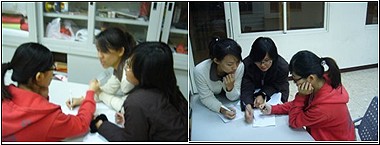 |
| |
 |
|
First Meeting
Material of NDHU Sunny Club |
|
Subject of
1st meeting: commencement
ceremony of volunteer teachers
The 1st meeting material of NDHU
Sunny Club
Topic of First Meeting:
Volunteer Teachers Commencement
Ceremony
Participants: Yueh-shan Lyu,
Jia-rong Lu, Wen-yun Hong
The chance to join Team member
plan as a volunteer teacher and
attend two days activity enables
us better understand the plan of
whole program and
implementation. Hope Agent
Development Association expects
the students to better
understand and develop the
culture of their hometown,
through our volunteer teachers’
assistance in organizing them to
research local culture with
depth. Moreover, enable the
students to connect with the
world via digital technology via
the process that publishes
ancestor’s wisdom as students’
research results and serves as
an information platform for
external use. Students in
Hualien can grow up as those in
city, not kept away from new
information because of remote
location.
The first night, we set up a
basic direction with Supervisor
Xu and teacher Ai, adopting
“Ramie”, the important weaving
element in traditional Truku
culture, as the subject, which
is seldom planted now with the
decline of weaving culture.
Teachers hope to re-attract
public attention to ramie
through the plan, in order to
produce more weaving materials
and promote weaving culture from
the foundation. In their memory,
ramie has multi-functions, used
as dental floss or to bind
stuff, because its stick is
coriaceous and tough, which
implied our cooperation would be
followed through. |
|
|
|